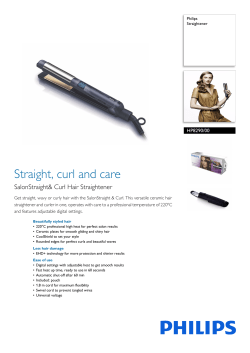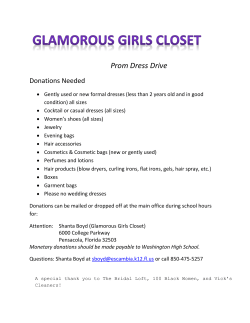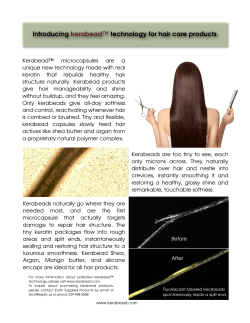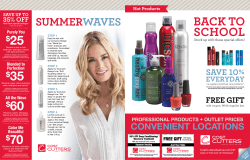
LESSON #5 Thermal Hairstyling
LESSON #5 Thermal Hairstyling 1. 2. 3. 4. 5. 6. Read Chapter 10, P. 330-364 in Salon Fundamental textbook. Complete questions in study guide. Read these additional notes. For review go to practice online and review quizzes, puzzles. Study and complete Test. A 70% is required for all theory and practical tests. TOPICS • • • • • • • • Hairstyling theory as it pertains to thermal hairstyling. The purpose of hairstyling products. Procedures in client consultation. Tools used in thermal styling and their uses. Techniques used for blow-drying the hair. Techniques for thermal hairstyling with curling irons. Techniques for thermal styling with hairstraighteners. Safety precautions when thermal hairstyling. Thermal Hairstyling is a term used to describe the use of heated implements for use on the hair. Tools classified as Thermal: Blow dryer Curling Iron Hair straightening Iron (flat iron) Straightening comb Metal lined brushes or combs that hold the heat when blow drying. Hairstyling theory • Hair is composed predominantly of proteins connected by both physical and chemical bonds. • Physical and bonds and hydrogen bonds are easily affected by both water and heat. • When heat is applied the hydrogen bonds are weakened, the protein chains shift and a temporary curl is formed. • When the hair cools; the bonds of the hair reform into the shape of the heated tool that was used. Do not disturb the hair until it is cool or the curl will become weak. • Do not stretch the hair while it is still warm, the curl pattern will not hold. • Water, shampoo, too much hairspray, rain and humidity will cause the hair to return to its original shape. • Remember this is a temporary service. Hairstyling Products Gel: Applied to the ends and root area to create maximum control of the hair when roller setting, creating pin curls or for added lift when blow-drying the hair. Spray Gel: Gel diluted with water to be used on thinner hair. When diluted it does not weigh the hair down and more volume can be produced. Mousse: Produced to coat the hair to add lift and body, assists in static in the hair, can contain some conditioning elements. Mousse can be purchased in colors for decorative purposes and also as a temporary color rinse. Styling Lotion: Applied from a spray bottle to damp hair; used prior to setting the hair for maximum control and controls static. Non-Aerosol Hairspray: Applied from a spray bottle; used to set the hairstyle after a comb-out or blow-dry. When used from a pump it is wise not to use as much since it can wet the hair since when misting the droplets are larger than an aerosol can. Aerosol hairspray: Applied from an aerosol can; used to set the hairstyle after a comb-out or blow-dry. Aerosol hairsprays are not the best for the environment since they are not refillable and hard to dispose of. The fine mist of aerosol cans, after years of inhalation are harmful to the lungs. Pomade: A wax or heavy cream base product used for defining key areas in the hairstyle; such as wisps in a bang area or around the hairline. Pressing spray or oil: Applied to the hair prior to straightening the hair; used to protect from extreme heat of flat irons or hair straighteners. Client consultation The client consultation is the key to the entire service. During the consultation you will, greet, ask, analyze and assess the hair. This will allow you to agree, deliver and complete the service with confidence and success. Greet: First impressions are lasting ones. Your professional images a big smile and a hand shake and a friendly greeting will warm your client and make them feel welcome. Ask, Analyze, and Assess: • Ask as many questions you can to determine the client’s wishes. • Analyze the client’s hair for cuts, abrasions and condition of the hair. • If the hair is not healthy you will not be able to complete some of the requested chemical services. • Examine facial features and scull formation before designing hairstyles for clients. Assess the hair for product usage. Is their color on the hair? Do they use a lot of hairspray or gel? Is their hair long enough for the requested style? Agree: Show them pictures to make sure you are both talking about the same hairstyle. Discuss the cost of the entire service and the products required to keep the hairstyle looking professional. Deliver: Protect the client’s clothing, follow all safety rules and focus on delivering the service to the best of your ability. Complete: the style and request feedback from your client. Suggest followup appointments and products if necessary. Tools used and their purpose. Blow Dryers Used for drying the hair into a new hairstyle; also called air-forming. The nozzle fits on the end of the blow-dryer and is used to aim the air to a certain area. The nozzle prevents splits ends if you follow the blow-dryer’s direction towards the ends of the hair. Blow-dryers are used in adjacent with a brush or comb, depending on the hairstyle that was chosen. Diffusers spread a gentle air over a large area and not a large spread of wind as with the blow-dryer on its own. It is also known as scrunching. To be used on curly hair or to create body in the hair allowing it to dry in it’s natural state. Read the manufacturer’s direction for settings on your blow-dryer before use. Round brushes create the shape the hair will be in when dry. When choosing the correct brush analyze the length of the hair and the size of the curl desired. Vent Brushes will create a straighter look in the hair and are often used to dry the hair prior to hair-straightening. Curling irons or thermal irons come in a variety of sizes and are used to add curl to straight hair. The variety of sizes allows you to decide on the size of curl. Pressing combs, Hair-straighteners are used to straighten hair that is too curly. Pressing combs are not as popular today and hair straighteners with stoves are mainly used for very curly black hair TOOLS BLOWDRYER Flat Iron Curling Iron Round Brushes Vent Brush ROLLER BASES ON BASE • Comb hair forward at a 45 degree angle this creates high volume and an on base roller. HALF OFF BASE • Comb hair straight up at 90 degrees. This will create a half off base or medium volume curl. OFF BASE • Comb hair down at a 45 degree angle. This will create a low volume curl. Technique for on base curl • When blow drying the hair you should always have the nozzle aimed at the ends of the hair. This prevents split ends and controls the air on the hair you want to dry. Low Volume Indentation Off Base • Hold the hair at 45 degrees down and hold your brush upwards, this turns the ends up instead of under. VENT BRUSH • Vent brushes are used to straighten hair or to create feathered back looks. Use small sections of hair for best results. ON BASE CURLING IRON TECHNIQUE • Section hair for control • Comb hair back at a 45 degree angle. • Using a preheated curling iron place in section of hair. • Press firmly with your right hand. • Swing hair around barrels and place the little finger in handle, continue clicking handle and feed hair into the barrel, wrapping the ends as you go. • Once hair is secured in the barrel, place a comb under the curling iron to prevent scalp burns. • Hold iron in hair until it is hot to touch. • Remove iron by clicking tongue and barrel in a continuous motion. • On Base Curl with the use of a curling iron. • Half Off Base curl with the use of a curling iron. • Hair is held at 90 degrees and curled to half off the back base. • Off Base curl with the use of a curling iron. • Hair is held at 45 degrees back. • The curl will sit off the back base. Thermal Irons • • • • Introduced by Marcel Gateau in 1875 Also called Marcel irons or curling irons Add curl or texture to the hair. Thermal irons come in a variety of sizes and shapes, straightening irons or flat irons, crimping irons and undulating irons. • Contain heating element controlled by a thermostat that maintains a constant temperature during use. PARTS OF A CURLING IRON Groove, Shell or Tongue Rod Handle Swivel Barrel Shell Handle • Most professional curling irons have a swivel handle that permits the electric cord to turn, without twisting. • Barrel/Rod contains the heating element. • Groove/Shell is sometimes called the tongue or clamp used to hold the hair in place while curling. • Shell/Handle used to control the tension of the groove or shell • Rod/Handle contains the temperature controls. • • • • HAIRSTRAIGHTENING To straighten hair with an electric hairstraightener the iron has to be hot. Regulate heat settings according to the texture of the hair. If hair is fine use a very low setting. If hair is coarse use a high setting. • Open the Hairstraightener, Place the hair between the two heating elements. • Grip the straightener firmly squeezing the hair and sliding down the hair shaft at the same time. • The pressure and heat will press the hair like an iron over clothing. • The end result will be a smoothed cuticle and very straight hair. • Caution should be taken when close to the scalp. The iron is very hot and can burn the scalp. • Products can be applied to the hair prior to straightening to protect the hair and assist in straightening. INDENTATION WITH HAIRSTRAIGHTENER • Smooth the cuticle straight from the roots to the ends. • When you get to the end turn the straightener upwards. • Remove the iron and the hair will be flipped up. BEVELLED UNDER • If client wants to have their hair curled under, you can use the hairstraightener. • Straighten the hair from the scalp to the ends, turn the iron under and hold for a few d • This style is very nice for clients that have a one length hairstyle.
© Copyright 2025









